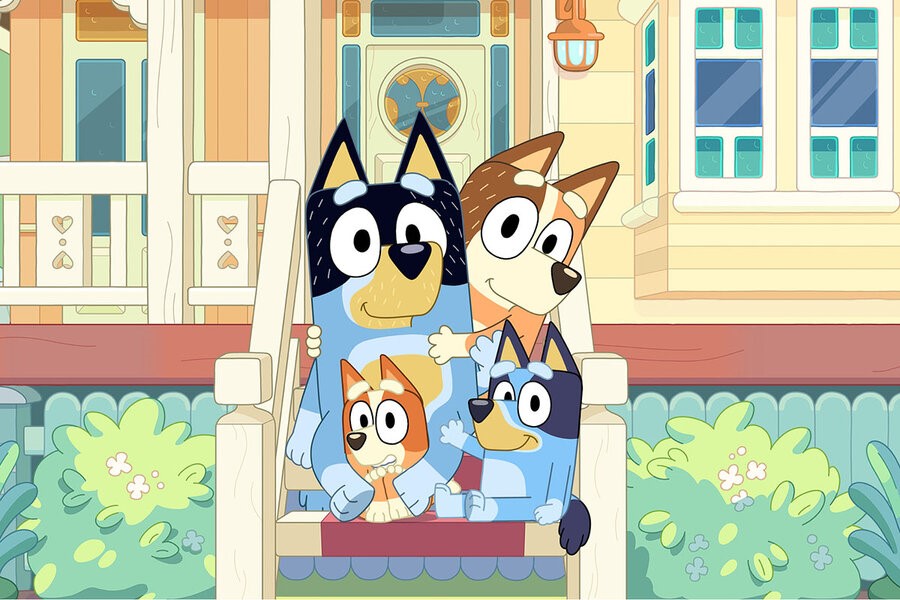“Bluey” has won worldwide acclaim for dealing with adult issues with remarkable gentleness and honesty, reminding us that the best children’s shows are so much more than children’s shows.
 “Bluey,” the animated children’s show on Disney+ about a family of Australian cattle dogs, handles issues with such gentleness and compassion that makes it the best children’s show since “Sesame Street,” our commentator writes. Disney+
“Bluey,” the animated children’s show on Disney+ about a family of Australian cattle dogs, handles issues with such gentleness and compassion that makes it the best children’s show since “Sesame Street,” our commentator writes. Disney+
I have always been impressed by the power of good children’s programming – the type of television that can also have a profound effect on adults. The sounds and sights draw us in – the playful jingle of “CoComelon,” or the journey through the tunnel into the sprawling world of “Fraggle Rock.”
“Bluey,” the animated children’s show about a family of Australian cattle dogs, has had a similar effect in my household and beyond. Much of the world knows about “Bluey.” How it talks about adult issues like aging or infertility with a gentleness and honesty that makes it compelling viewing no matter what your age. And every father who watches secretly wants to be Bandit, the main character’s dad.
It reminds me of the cultural relevance of “Sesame Street.” Even now, I can hear the reassuring doo-wop of the Pointer Sisters as a pinball races through various machinations. “One, two, three, four, five, six, seven, eight, nine, 10, 11, 12,” their voices ring in soulful, funky harmony. “Sesame Street” taught me numbers, yes. But it also taught me respect, kindness, and curiosity.
Time magazine once said the greatest achievement of Jim Henson, architect of “Sesame Street” and “Fraggle Rock,” was helping to “sustain the qualities of fancifulness, warmth and consideration that have been so threatened by our coarse, cynical age.”
“Bluey,” on Disney+, has this gift as well. In the case of my family’s favorite episode, “Rain,” this sense of compassion is achieved in relative silence. The only audible voices are within the first few seconds – a series of goodbyes from the title character and her mother, Chilli. Then, a rumble of ominous thunder takes the pair in different directions – Bluey into playtime, and Chilli into a rush to yank the clothes off the line.
The episode is a reminder of how childhood and parenthood – so often in conflict – can quickly lead to unscripted joy and unlooked-for grace. Chilli’s housecleaning efforts are thwarted when Bluey turns her mother’s work into a messy dam in the driveway. In the episode’s climax – a literal push-and-pull between mother and daughter – Chilli is unable to keep Bluey from leaving wet paw prints through the house. So she lies on the floor in what appears to be defeat before eventually joining in the mischief.
“Rain” has brought my family together. My 2-year-old began to mimic Bluey’s sloshy rush toward the door into either my arms or my wife’s. Before he could communicate words, he was able to express his approval of “Bluey”!
Where “Sesame Street” endeared itself to generations through education and representation, Bluey’s calling card is its empathy. The result is the show’s remarkable ability to handle tough situations with an infusion of love and understanding.
In “Onesies,” an episode that subtly addresses infertility and the situations that can separate families, Bluey inquires:
“Mum, why did Auntie Brandy want to leave? Is she sad? And why have we only seen her once in our lives?”
“You know how you really want Bingo’s cheetah onesie?” Chilli responds. “But it doesn’t fit you, so you can’t have it. And there’s not anything anyone can really do to make it fit.”
“Why can’t she just have the thing she wants?”
“Because it’s not meant to be.”
Combined with the visual of Bingo in a cheetah onesie running away from Brandy, it makes for heart-wrenching, insightful television.
I recently walked through a toy aisle and saw a “Bluey” toy that featured a sanitation worker. I can remember as a kid how much people derided folks who made a living taking out the garbage. Young people who said they wanted to be a custodian as an adult got teased.
As a teacher’s kid, I knew better. I thought the world of “Mr. Raymond,” the custodian who was the first person to get there in the morning and the last one to leave. His surname, Bright, captured the essence of how he engaged teachers and children.
The first line of a classic tune by The Stylistics is an ode to striking sanitation workers, and their reprise is a reminder, much like Bluey, that people make the world go round.
“Bluey” deserves all of its critical acclaim. Its cast of characters, including Bluey and Bingo’s doting, do-it-all father, is worth celebrating. But the defining component of shows such as “Bluey” and “Sesame Street” is that they don’t just build core memories.
They build positive character attributes. And that is something we never age out of.
Page created on 10/16/2023 9:52:45 AM
Last edited 11/1/2023 5:11:52 PM
